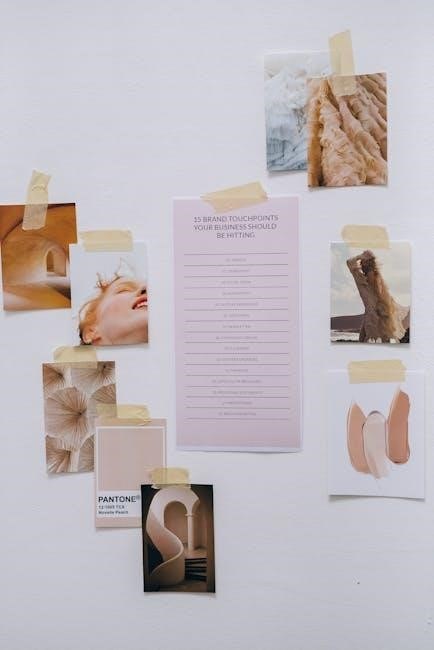DBT Diary Cards are essential tools in Dialectical Behavior Therapy, helping individuals track emotions, behaviors, and skill use daily. They facilitate self-awareness, accountability, and progress in therapy.
1.1 What Are DBT Diary Cards?
DBT Diary Cards are tools used in Dialectical Behavior Therapy to track emotions, behaviors, and skill use. They are typically filled out daily, providing a structured way to monitor progress and identify patterns. These cards often include sections for rating emotional intensity, noting urges, and documenting the use of DBT skills like mindfulness or distress tolerance. They may also track target behaviors, such as self-harm or substance use, and whether these behaviors were acted upon. The cards serve as a visual record of daily experiences, helping individuals and therapists understand trends and areas for improvement. They are a key component of DBT, fostering accountability and insight into one’s emotional and behavioral responses. By using these cards, individuals can better manage their emotions and develop healthier coping strategies.
1.2 The Role of Diary Cards in DBT Therapy
Diary Cards play a central role in DBT therapy by providing a structured tool for tracking emotions, behaviors, and skill use. They help individuals identify patterns in their emotional responses and behaviors, enabling better self-awareness and accountability. These cards serve as a bridge between therapy sessions, offering therapists valuable insights into a client’s progress and challenges. By documenting daily experiences, Diary Cards facilitate meaningful discussions during therapy, allowing for targeted interventions and skill development. They also help individuals stay focused on their treatment goals and reinforce the use of DBT skills in real-life situations. Ultimately, Diary Cards enhance the effectiveness of therapy by promoting consistent self-monitoring and collaboration between client and therapist.
Structure of a DBT Diary Card
A DBT Diary Card typically includes sections for rating emotions, tracking urges, and documenting skill use. It may also have areas for notes and progress tracking, aiding in identifying patterns and monitoring therapy advancements.
2.1 Sections for Emotions and Urges
DBT Diary Cards often include sections for rating emotions and tracking urges. These sections typically feature a numerical scale (0-5) to assess the intensity of emotions like anger, fear, or sadness. Checkboxes or columns allow users to mark specific emotions experienced daily. Additionally, there are areas to note urges related to target behaviors, such as self-harm or substance use, and whether these urges led to actions. This structure helps individuals identify patterns in emotional responses and triggers, providing clarity on when and how skills were used to manage these feelings. By documenting emotions and urges, users gain insight into their emotional landscape, enabling better regulation and decision-making in therapy.
2.2 Sections for Skills Tracking
DBT Diary Cards include dedicated sections for tracking the use of DBT skills, such as mindfulness, distress tolerance, and emotional regulation. These sections often feature checkboxes or lists where users can mark which skills they practiced each day. Skills are typically categorized by DBT modules, making it easy to monitor progress. This section helps individuals identify which skills they are using effectively and which ones they may need to focus on more. By documenting skill use, users can reflect on their effectiveness and discuss areas for improvement with their therapist. This structured approach ensures accountability and reinforces the consistent practice of skills, which is central to DBT’s goal of building a life worth living.
How to Fill Out a DBT Diary Card
Fill out your DBT Diary Card daily, rating emotions, urges, and behaviors on a scale. Track skill use and note any challenges or successes to identify patterns and prepare for therapy.
3.1 Daily Tracking of Emotions and Behaviors
Daily tracking of emotions and behaviors is a cornerstone of DBT Diary Cards. Each day, individuals rate the intensity of emotions like anger, fear, and sadness on a scale, typically from 0 to 5. They also note urges, such as self-harm or substance use, and whether these urges led to actions. This process helps identify patterns and triggers, providing insight into emotional and behavioral cycles. By documenting these details, users can better understand their experiences and develop strategies to manage them. The daily tracking also includes space to record skills used, reinforcing their practice and effectiveness. This consistent monitoring creates a clear record for therapy sessions, aiding in progress review and goal setting. Regular use enhances self-awareness and accountability, making it easier to address challenges and celebrate successes.
3.2 Rating Scales for Intensity and Frequency
DBT Diary Cards utilize rating scales to assess the intensity and frequency of emotions and behaviors. Emotions like anger, fear, and sadness are rated on a 0-5 scale, with 0 indicating no intensity and 5 representing extreme intensity. Similarly, urges to engage in target behaviors, such as self-harm or substance use, are also rated. This system helps individuals identify patterns and triggers, enabling better emotional regulation. The frequency of skill use is tracked, reinforcing consistent practice. These scales provide clear, quantifiable data, making it easier to monitor progress and discuss insights in therapy. By documenting intensity and frequency, users gain a deeper understanding of their emotional and behavioral cycles, aiding in more effective management and growth.

Types of DBT Diary Cards
Various DBT Diary Card styles exist, including traditional, streamlined, daily planner-style, customizable spreadsheets, and cards tailored for specific issues like eating disorders or adolescent needs.
4.1 Traditional Diary Card
The traditional DBT Diary Card, as outlined in Marsha Linehan’s workbook, features two main sections. The first section includes boxes for rating emotions and urges on a numerical scale, with columns to track whether target behaviors were used. This allows individuals to monitor the intensity of emotions and the frequency of problematic behaviors. The second section lists DBT skills, enabling users to check off which skills they practiced each day. This structure helps individuals identify patterns and areas for improvement. The traditional card is straightforward and widely used, making it a reliable tool for both clients and therapists to review progress during sessions.
4.2 Streamlined Diary Card
The streamlined diary card is a simpler version of the traditional format, designed to reduce clutter while retaining essential elements. It includes sections for tracking emotions, urges, and DBT skills but presents them in a less busy layout. This version is ideal for individuals who prefer a more minimalist approach or find the traditional card overwhelming. The streamlined design focuses on clarity, making it easier to quickly review and update daily progress. It still allows for effective pattern identification and skill monitoring, ensuring that users can maintain consistency without feeling burdened. This adaptable format is particularly useful for those who value simplicity but still want to benefit from the structure of a diary card.
4.3 Daily Planner-Style Diary Card
The daily planner-style diary card combines DBT tracking with daily scheduling, offering a holistic approach to managing time and mental health. This format includes sections for emotions, skills, and behaviors, alongside spaces for to-do lists and schedules. It helps users integrate their therapy progress into their daily routines, promoting organization and mindfulness. The planner-style card is ideal for those who prefer a structured yet flexible tool. It allows for tracking patterns while also planning tasks, making it a practical choice for individuals seeking to balance productivity with emotional well-being. This design encourages consistency in both skill practice and daily responsibilities, fostering a sense of control and accomplishment.
4.4 Customizable Spreadsheet Diary Card
The customizable spreadsheet diary card offers a flexible and detailed approach to tracking emotions, behaviors, and skills. It allows users to tailor sections to their specific needs, such as adding or removing columns for emotions or skills. The spreadsheet format enables easy data analysis, helping users identify patterns over time. This version is particularly useful for those who prefer a more structured or quantitative approach. It can be adapted to focus on specific issues, such as emotional regulation or crisis management. By personalizing the diary card, individuals can ensure it aligns with their therapy goals and preferences, making it a powerful tool for self-monitoring and progress tracking.
4.5 Diary Cards for Specific Issues
Diary cards for specific issues are tailored to address particular challenges, such as eating disorders, substance use, or crisis management. These cards include targeted sections for tracking emotions, behaviors, and skills relevant to the issue. For example, a diary card for eating disorders might focus on hunger cues, cravings, and coping strategies. Similarly, a card for substance use could track urges, triggers, and relapse prevention skills. These specialized cards allow individuals to concentrate on their unique struggles, making tracking more relevant and effective. They often include space for crisis plans or affirmations, providing immediate support during difficult moments. This focused approach helps individuals and therapists address specific behaviors and emotions, enhancing the effectiveness of therapy and promoting meaningful progress.
Benefits of Using DBT Diary Cards

DBT Diary Cards help identify emotional and behavioral patterns, enhancing self-awareness and accountability. They facilitate progress in therapy by providing clear insights and tracking skill development effectively.
5.1 Identifying Patterns in Emotions and Behaviors
DBT Diary Cards are invaluable for identifying patterns in emotions and behaviors by tracking daily experiences. By rating emotions and urges on a scale, individuals can observe recurring themes and triggers. This consistent documentation reveals cycles in emotional intensity and frequency, helping to pinpoint specific skills or strategies needed. Over time, the diary card highlights trends, such as certain emotions or behaviors occurring consistently under specific circumstances. This insight enables individuals to anticipate and prepare for challenging situations. Additionally, the diary card aids in monitoring progress, showing how skills are applied and where more practice is necessary. This pattern recognition is a cornerstone of DBT, empowering individuals to make informed decisions and work toward lasting change.

5.2 Enhancing Self-Awareness and Accountability
DBT Diary Cards play a crucial role in enhancing self-awareness by providing a daily record of emotions, urges, and behaviors. This consistent tracking helps individuals gain insight into their emotional states and actions, fostering a deeper understanding of themselves. By documenting their experiences, users develop accountability, as they are encouraged to reflect on their choices and progress. The diary card serves as a tool for personal responsibility, promoting honesty about skill use and challenges faced. This heightened self-awareness enables individuals to recognize areas for improvement and take ownership of their growth. Over time, this process cultivates a stronger sense of self and empowers individuals to make intentional decisions aligned with their goals.
5.3 Facilitating Progress in Therapy
DBT Diary Cards significantly contribute to therapy progress by providing a clear, structured format for tracking emotions, behaviors, and skill use. This documentation allows therapists to identify patterns and areas needing attention, enabling focused discussions during sessions. The diary card serves as a visual aid, helping both client and therapist monitor improvements and setbacks. It also facilitates goal setting and skill prioritization, ensuring therapy remains targeted and effective. Regular use of diary cards fosters a collaborative approach, where clients actively participate in their treatment. This tool not only enhances communication but also accelerates the therapeutic process, helping individuals achieve their goals more efficiently. By maintaining a consistent record, clients can celebrate progress and address challenges promptly, leading to meaningful and lasting change.

How Therapists Use Diary Cards in Sessions
Therapists use diary cards to review progress, set priorities, and support discussions. They help identify patterns, understand challenges, and guide targeted skill development, enhancing session effectiveness.
6.1 Reviewing Progress and Setting Priorities
Therapists use diary cards to assess progress, identify patterns, and set priorities for sessions. By reviewing tracked emotions, behaviors, and skill use, they gain insights into challenges and strengths. This helps in tailoring therapy to address specific needs, ensuring focused and effective sessions. Diary cards also reveal areas where skills are underutilized, guiding therapists to emphasize certain strategies. This collaborative process allows clients to stay accountable and motivated, fostering a clearer path toward therapeutic goals. The structured data from diary cards enables therapists to prioritize discussions, making each session more impactful and aligned with the client’s journey toward a life worth living.
6.2 Conducting Behavior Chain Analysis
Therapists use diary cards to conduct behavior chain analyses, breaking down sequences of events leading to problematic behaviors. By examining recorded emotions, urges, and actions, clients and therapists identify triggers and consequences. This process helps clarify how skills were applied or missed, revealing opportunities for improvement. Diary cards provide concrete data, making it easier to pinpoint patterns and understand the flow of events. This collaborative analysis fosters deeper insight into behaviors and enhances problem-solving. It also strengthens the client’s ability to recognize and modify unhelpful patterns, promoting more adaptive responses in the future. Behavior chain analysis is a powerful tool for understanding and changing maladaptive behaviors, guided by the detailed information in diary cards.

Customizing Your DBT Diary Card
Customizing your DBT diary card allows you to tailor it to your specific needs, whether through traditional, streamlined, or planner-style formats. Choose designs that suit your preferences, such as spreadsheets or apps, and add sections for affirmations, crisis plans, or skill tracking. This personalization enhances usability and ensures the card remains a helpful tool for your mental health journey.
7.1 Choosing a Design That Suits Your Needs
Choosing a design for your DBT diary card is a personal decision that depends on your preferences and goals. Traditional diary cards, like those in Marsha Linehan’s workbook, offer a structured format with sections for emotions, urges, and skills. Streamlined versions simplify this layout, reducing clutter for a cleaner look. Daily planner-style cards combine emotion tracking with practical tools like to-do lists and schedules. For tech-savvy users, digital apps provide interactive features and ease of use. Customizable spreadsheets allow you to tailor sections to your specific needs, such as adding crisis plans or affirmations. Explore these options to find a design that feels intuitive and motivating, ensuring consistent use and progress in your therapy journey.
7.2 Examples of Customizable Templates
Customizable DBT diary card templates offer flexibility to suit individual needs. The traditional diary card includes sections for emotions, urges, and skills, providing a comprehensive tracking system. The streamlined version simplifies this format, reducing clutter for those who prefer minimalism. A daily planner-style card combines emotion tracking with practical tools like to-do lists and schedules. For those who prefer structure, customizable spreadsheets allow users to tailor sections, such as adding crisis plans or affirmations. Many templates also include space for notes or reflections, enhancing personalization. These designs ensure that users can adapt the tool to their unique preferences and therapy goals, making the diary card a more effective and engaging resource for their mental health journey.
Digital Tools for DBT Diary Cards
Digital tools like DBT diary card apps offer convenient tracking of emotions, urges, and skills. Features include password locking, entry editing, and progress charts, enhancing therapy effectiveness and accessibility.
8.1 DBT Diary Card Apps
DBT Diary Card apps are innovative tools designed to modernize the traditional diary card experience. These apps, such as those created by licensed psychologists, offer features like password locking to ensure privacy and security. Users can easily track their daily emotions, urges, and skill usage, with options to edit or delete entries as needed. Many apps also provide visual progress charts, helping individuals identify patterns and improvements over time. Some apps include crisis plans and affirmations to support self-encouragement during challenging moments. Testimonials highlight their effectiveness, with users praising their life-saving potential. With a variety of options available, these apps cater to diverse needs, making DBT skills more accessible and engaging for individuals in therapy.
8.2 Features of Digital Diary Card Tools
Digital diary card tools offer a range of features that enhance the traditional DBT diary card experience. These tools often include customizable templates, allowing users to tailor sections for emotions, urges, and skill tracking to suit their needs. Many platforms provide visual charts and graphs to help identify patterns in behavior and progress over time. Some tools also incorporate affirmations and crisis plans, offering immediate support during difficult moments. Password protection ensures privacy, while cloud syncing allows access across multiple devices. Additionally, digital tools may include reminders to encourage consistent use and provide a space for notes and reflections. These features make digital diary cards a versatile and effective resource for managing emotions and behaviors in DBT therapy.

Affirmations and Crisis Plans

Affirmations are positive statements that boost self-confidence and self-love, while crisis plans provide immediate support during difficult moments. Both can be included in diary cards for easy access.
9.1 Using Affirmations for Self-Encouragement
Affirmations are powerful, positive statements that help individuals build self-confidence and self-love. In DBT, they are often included in diary cards to provide quick access to encouraging phrases. These affirmations are designed to help individuals reframe negative thoughts and cultivate a more positive mindset. They can be personalized to address specific challenges or emotions, making them a versatile tool for emotional regulation. For example, affirmations like “I am capable of handling this moment” or “I deserve kindness and compassion” can be particularly helpful during difficult times. By incorporating affirmations into diary cards, individuals can easily refer to them when needed, reinforcing positive self-talk and staying motivated to use DBT skills. This practice aligns with the therapy’s goal of fostering resilience and self-encouragement.
9.2 Including a Crisis Safety Plan

A crisis safety plan is a vital component often included in DBT diary cards to help individuals manage intense emotions and prevent harmful behaviors. This plan outlines specific coping strategies, such as deep breathing, mindfulness exercises, or contacting a trusted person, to use during emotional crises. It also lists emergency contacts, like a therapist or crisis hotline, to ensure immediate support is accessible. By having this plan readily available, individuals can act quickly to de-escalate stressful situations without resorting to maladaptive behaviors. Incorporating a crisis safety plan into diary cards ensures it is always within reach, providing a sense of control and preparedness during overwhelming moments. This tool aligns with DBT’s focus on enhancing emotional regulation and promoting safety.

Resources for DBT Diary Cards
Find free DBT diary card templates online, along with recommended books and websites, to support your mental health journey and therapy progress effectively.
10.1 Where to Find Free DBT Diary Card Templates
Free DBT diary card templates are widely available online, offering customizable designs to suit individual needs. Websites like DBT Self-Help provide downloadable PDFs for tracking emotions, behaviors, and skill use. These templates are easy to print and use, making them ideal for personal or therapeutic use. Additionally, many mental health resources and therapy websites offer free diary card templates tailored for specific issues, such as borderline personality disorder or eating disorders. You can also find templates in various formats, including daily, weekly, or planner-style designs. For added convenience, some templates are available as spreadsheets or through mobile apps, allowing for digital tracking. These resources empower individuals to take an active role in their mental health journey, ensuring accessibility and flexibility.
10.2 Recommended Books and Websites
For comprehensive resources on DBT diary cards, consider Marsha Linehan’s workbook, which provides foundational guidance on using diary cards effectively. Websites like DBT Self-Help offer extensive free templates, tutorials, and downloadable PDFs. Additionally, YouTube channels dedicated to DBT often share video guides and tips for using diary cards. For further reading, “The Dialectical Behavior Therapy Skills Workbook” by Matthew McKay and others is highly recommended. These resources provide practical tools and insights to enhance your DBT journey, ensuring you have the support needed to track progress and manage emotions effectively. Explore these recommendations to deepen your understanding and implementation of DBT diary cards in your daily life.
Conclusion
DBT Diary Cards are powerful tools for managing emotions, behaviors, and skill development, offering a structured way to track progress and identify patterns. By consistently using these cards, individuals can enhance self-awareness, accountability, and their ability to live a life worth living. The availability of customizable templates, apps, and resources ensures that diary cards can be tailored to meet individual needs. Whether used in therapy or independently, DBT Diary Cards provide a clear record of experiences and growth, making them an invaluable asset for mental health journeys. Embrace consistency in using these tools to maximize their benefits and foster lasting positive change.
